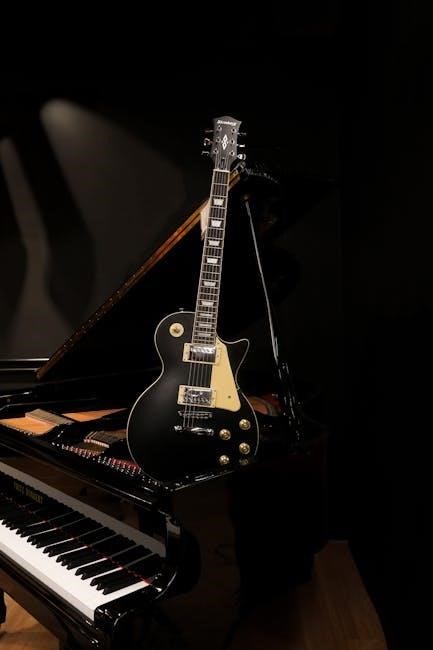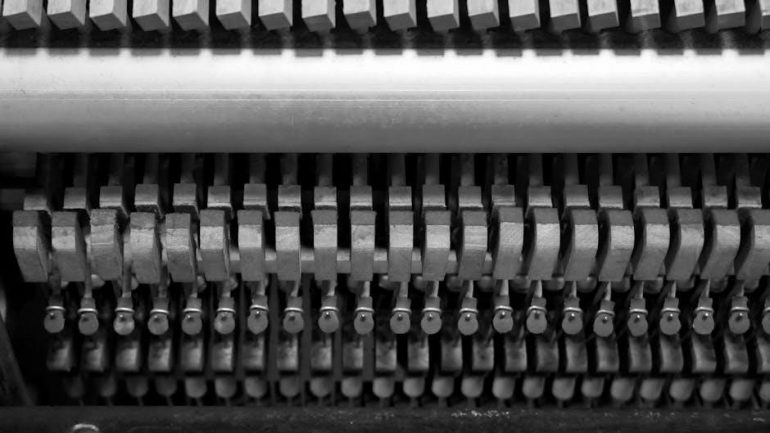The AMEB Piano Syllabus is a comprehensive guide for pianists, offering structured learning and assessment opportunities. Established by the Australian Music Examinations Board, it provides a framework for developing musical skills, from beginner to advanced levels. The syllabus includes technical work, repertoire, and practical exams, ensuring well-rounded musical education. With regular updates and resources like the 2025 AMEB Piano Syllabus PDF, it remains a trusted tool for students and teachers nationwide.
Overview of the AMEB Piano Syllabus
The AMEB Piano Syllabus provides a structured framework for pianists to progress from beginner to advanced levels. It offers a comprehensive approach, combining technical work, repertoire performance, and practical exams. The syllabus is designed to cater to diverse learning styles, with options like Piano for Leisure and Collaborative Piano. Regular updates, such as the 2024 Piano for Leisure Certificate of Performance Manual List, ensure the content remains relevant and engaging. Students can access resources like the 2025 AMEB Piano Syllabus PDF for free, making it accessible for everyone. This syllabus is a trusted guide for both students and teachers, fostering musical growth and excellence.
Importance of the AMEB Piano Syllabus for Students
The AMEB Piano Syllabus plays a crucial role in shaping pianists’ musical journeys. It provides a clear, structured pathway for skill development, helping students build confidence and mastery. By offering a balanced approach to technical work, sight-reading, and repertoire, the syllabus ensures holistic musical education. The availability of resources like the 2025 AMEB Piano Syllabus PDF allows students to access exam requirements and practice materials easily. This structured learning not only prepares students for exams but also fosters a lifelong appreciation for music. The syllabus’s emphasis on both classical and contemporary styles caters to diverse interests, making it an invaluable tool for aspiring pianists.
Structure of the AMEB Piano Exams
The AMEB Piano exams are structured to assess technical proficiency, musicality, and performance skills. Exams typically include technical work, such as scales and arpeggios, as well as the performance of repertoire pieces. Sight-reading and aural tests are also integral components, evaluating a candidate’s ability to play unfamiliar music and understand musical elements. The exams are divided into grades, with increasing difficulty, and cater to both classical and contemporary styles. The AMEB Piano Syllabus PDF provides detailed requirements, ensuring clarity for preparation. This structured approach helps students progress systematically, while the variety of exam formats, such as Piano for Leisure, allows candidates to tailor their assessments to their musical interests.

AMEB Piano Syllabus Updates and Revisions
The AMEB Piano Syllabus undergoes periodic updates to reflect contemporary music trends and educational needs. Recent revisions include expanded repertoire lists and new technical requirements, enhancing exam flexibility and relevance. These updates ensure the syllabus remains a dynamic tool for pianists. The 2025 AMEB Piano Syllabus PDF offers detailed insights into these changes, providing a comprehensive guide for students and teachers.
2019 AMEB Piano Syllabus Updates
The 2019 AMEB Piano Syllabus introduced significant enhancements, including the addition of a Collaborative Piano option for Grades 5 to 8. This innovation allowed students to perform with other instruments, such as violin or flute, fostering ensemble skills. Additionally, the syllabus expanded its repertoire, incorporating diverse styles to cater to modern musical tastes. Technical work adjustments were also made to improve clarity and progression. These updates aimed to enrich the learning experience and prepare students for versatile musical careers. The 2019 AMEB Piano Syllabus PDF provides detailed information on these changes, ensuring teachers and students can effectively utilize the revised framework.
2020 AMEB Piano Syllabus Revisions
In 2020, the AMEB Piano Syllabus underwent further refinements, building on the 2019 updates. The revisions introduced the release of Series 18 grade books, recordings, and handbooks, aligning with the updated syllabus requirements. These resources provided students and teachers with fresh repertoire and practical tools. Additionally, the Piano for Leisure syllabus saw expansions, offering more contemporary and diverse repertoire choices. Technical work adjustments were also implemented to enhance clarity and progression. The 2020 revisions aimed to maintain the syllabus’s relevance and accessibility, ensuring it catered to evolving musical education needs. The 2020 AMEB Piano Syllabus PDF remains a key resource for understanding these changes.
2024 Piano for Leisure Certificate of Performance Manual List
The 2024 Piano for Leisure Certificate of Performance Manual List introduces a refreshed selection of repertoire for candidates. Nearly 60 new works have been added, offering a diverse range of styles and periods. This update ensures students can engage with contemporary and classical pieces, fostering musical versatility. The manual list is available for download, providing clear guidelines for exam preparation. Teachers and students can access this resource through the AMEB Federal Office, ensuring they stay updated with the latest syllabus requirements. This revision reflects AMEB’s commitment to enriching musical education and providing meaningful performance opportunities for pianists.
Collaborative Piano Options for Grades 5 to 8
AMEB now offers collaborative piano options for Grades 5 to 8, enabling students to perform with other instrumentalists or vocalists. This initiative encourages ensemble playing, enhancing musical interaction and teamwork. Candidates can collaborate in duos such as piano and violin, clarinet, or flute, broadening their artistic expression. This option is part of the updated syllabus, available in the 2025 AMEB Piano Syllabus PDF. It provides students with diverse performance opportunities, preparing them for real-world musical collaborations. This addition enriches the learning experience, fostering creativity and adaptability among young pianists.

Technical Work and Exam Requirements
Technical work in the AMEB Piano Syllabus includes scales, arpeggios, and exercises. These are essential for building finger dexterity and understanding music theory. The 2025 AMEB Piano Syllabus PDF outlines specific requirements for each grade, ensuring a comprehensive approach to technical mastery.
Technical Work from the 2008 Edition
The 2008 AMEB Piano Syllabus includes specific technical work requirements, such as scales, arpeggios, and exercises. These exercises focus on developing finger dexterity, strength, and coordination. The syllabus emphasizes proper technique and musical understanding. Students are expected to perform these technical exercises accurately and with expression. The 2008 edition provides a foundational approach to technical mastery, which is still referenced today. While the 2019 syllabus introduced new updates, the 2008 technical work remains a valuable resource for teachers and students. It ensures a solid technical grounding, essential for advancing in piano studies; The 2025 AMEB Piano Syllabus PDF also includes supplementary materials for technical practice.
Scales and Arpeggios in the AMEB Piano Syllabus
Scales and arpeggios are fundamental components of the AMEB Piano Syllabus, focusing on technical proficiency. Students are required to perform major and minor scales, as well as arpeggios, in various keys. These exercises enhance finger independence, dexterity, and harmonic understanding. The syllabus outlines specific scales for each grade, ensuring a progressive learning curve. Practice materials and workbooks are available to aid preparation. The 2025 AMEB Piano Syllabus PDF includes detailed requirements for scales and arpeggios, ensuring clarity for both students and teachers. Mastery of these elements is crucial for advancing through the grades and achieving overall musical excellence.
Sight-Reading and Aural Tests in AMEB Exams
Sight-reading and aural tests are essential components of AMEB piano exams, assessing a student’s ability to interpret unseen music and demonstrate musical understanding. Sight-reading evaluates the ability to play unfamiliar pieces accurately, while aural tests focus on identifying musical elements like pitch, rhythm, and dynamics. These skills enhance overall musicianship and prepare students for real-world musical scenarios. The tests are tailored to each grade level, ensuring a progressive challenge. Resources like the 2025 AMEB Piano Syllabus PDF provide detailed guidelines, helping students and teachers prepare effectively. These assessments are integral to the syllabus, fostering comprehensive musical development and practical application.

Grade-Specific Information
The AMEB Piano Syllabus offers detailed grade-specific requirements, outlining technical work, repertoire, and performance expectations. The 2025 AMEB Piano Syllabus PDF provides comprehensive guidance for each level.
Grade 1 to Grade 8 Syllabus Details
The AMEB Piano Syllabus from Grade 1 to Grade 8 provides a structured progression for students. Each grade builds on the previous, refining technical skills and repertoire knowledge. The syllabus outlines specific requirements for technical work, such as scales and arpeggios, and offers a diverse range of repertoire pieces. Students are also assessed on sight-reading and aural tests, ensuring a comprehensive musical education. The 2025 AMEB Piano Syllabus PDF offers detailed grade-specific guidelines, helping students and teachers prepare effectively for exams. This resource is essential for understanding expectations and achieving success in AMEB assessments.
Leisure Piano Syllabus for Grade 5
The AMEB Leisure Piano Syllabus for Grade 5 offers a flexible and enjoyable approach to piano study. It caters to students who prefer a more relaxed style of learning, focusing on repertoire that aligns with their interests. The syllabus includes a diverse range of pieces, from classical to contemporary, allowing students to explore different musical genres. Technical work and sight-reading are also included to ensure well-rounded development. The 2025 AMEB Piano Syllabus PDF provides detailed requirements, making it easier for students and teachers to prepare for exams. This syllabus is ideal for those seeking a balanced and engaging musical education.
Piano for Leisure Certificate of Performance
The Piano for Leisure Certificate of Performance is a prestigious recognition awarded to candidates demonstrating exceptional skill and artistry. This certificate is available to students who achieve outstanding results in their exams, showcasing their mastery of both technical and repertoire requirements. The 2024 Piano for Leisure Certificate of Performance Manual List has been updated, introducing nearly 60 new works to broaden the selection for exams. This certificate serves as a milestone, acknowledging the candidate’s dedication and excellence in piano performance. It is a significant achievement that highlights their readiness for advanced musical challenges and opportunities.

AMEB Piano Diploma Requirements
The AMEB Piano Diploma is a distinguished qualification for advanced pianists, recognizing exceptional performance and musical understanding. Candidates must demonstrate mastery of complex repertoire, technical precision, and artistic expression. The diploma requires a high level of proficiency, with a focus on interpretation and nuance. Students are assessed on their ability to perform demanding works, showcasing their musicality and technical skill. The 2024 Piano for Leisure Certificate of Performance Manual List and other resources provide guidance on repertoire selection. Achieving this diploma is a significant milestone, reflecting the candidate’s readiness for professional performance and advanced musical pursuits. It is the pinnacle of achievement in the AMEB Piano Syllabus.

Resources for Students and Teachers
The AMEB offers a variety of resources, including the 2025 AMEB Piano Syllabus PDF, Series 15 and Series 16 grade books, and teaching guides. Students and teachers can access free downloads and practice materials from the AMEB Federal Office website, providing comprehensive support for exam preparation and musical development.
2025 AMEB Piano Syllabus PDF Download
The 2025 AMEB Piano Syllabus PDF is a comprehensive digital resource available for free download. It includes detailed syllabus information, exam requirements, and regulations for all instruments, with a focus on piano. This PDF is essential for students and teachers preparing for exams, offering insights into technical work, repertoire, and assessment criteria. The 2025 syllabus also features updates, including the refreshed Piano for Leisure Certificate of Performance Manual List, which adds nearly 60 new works. Accessible online, this PDF ensures easy preparation and understanding of the AMEB piano curriculum, making it a valuable tool for musical development and exam success.
Series 15 and Series 16 Grade Books
The Series 15 and Series 16 Grade Books are integral resources for AMEB piano students. Designed to align with the syllabus, these books provide carefully selected repertoire and technical exercises. Series 15 focuses on classical pieces, while Series 16 offers a blend of classical and contemporary works. Both series cater to different learning styles and preferences, ensuring a well-rounded musical education. Available for all grades, these books are indispensable for students preparing for exams. They complement the AMEB Piano Syllabus PDF, offering practical support for technical and performance development. Teachers and students rely on these grade books to achieve exam success and musical excellence.
Teaching Syllabus Resources and Guides
Teachers can access a wealth of resources to support their instruction of the AMEB Piano Syllabus. The AMEB Federal Office provides free downloads of Teaching Syllabuses and the Guide to Assessment, offering insights into exam expectations. These resources help educators understand grading criteria and performance standards. Additionally, the 2025 AMEB Piano Syllabus PDF includes detailed syllabus information, enabling teachers to plan comprehensive lessons. Workbooks, such as the Grade 1 Music Theory Exam workbook, also offer targeted practice materials. These tools ensure that teachers are well-equipped to guide students through their musical journey, fostering both technical proficiency and artistic expression.
Free Downloads from the AMEB Federal Office
The AMEB Federal Office offers a range of free downloadable resources to support both students and teachers. These include the Teaching Syllabuses, which provide detailed outlines of exam requirements and assessment criteria. Additionally, the Guide to Assessment is available, offering insights into performance expectations. Candidates can also access free scales and arpeggios sheets, as well as past exam papers, to aid in their preparation. Furthermore, the 2025 AMEB Piano Syllabus PDF is available for download, featuring updated syllabus details, technical work requirements, and repertoire lists. These resources ensure that everyone involved in the AMEB Piano exams is well-informed and prepared for success.

Practice and Preparation
Effective practice strategies, including structured workbooks and technical exercises, are essential for mastering the AMEB Piano Syllabus. Regular, focused practice ensures steady progress and exam success.

Workbook for Grade 1 Music Theory Exam
The workbook for the Grade 1 Music Theory exam provides comprehensive practice material, covering essential topics such as music notation, rhythm, and basic harmony. It includes exercises designed to reinforce understanding of fundamental concepts, preparing students for the exam. The structured format allows learners to progress systematically, ensuring a solid foundation in music theory. Additionally, the workbook aligns with the AMEB Piano Syllabus, making it an invaluable resource for both students and teachers aiming to achieve exam success. Regular use of the workbook helps build confidence and competence in music theory, which is crucial for overall musical development.
Practice Materials for Technical Work

The AMEB Piano Syllabus offers a range of practice materials for technical work, including scales, arpeggios, and exercises. These resources are designed to help students master the technical skills required for exams. The Technical Workbook from the 2008 edition provides detailed exercises to improve finger dexterity and control. Additionally, the Series 15 and Series 16 Grade Books include specific technical exercises tailored to each grade level. These materials, along with supplementary resources, ensure a thorough preparation for technical work in AMEB exams. Teachers and students can access these materials through the AMEB Federal Office website, enhancing their practice routines and exam readiness.
Strategies for Effective Piano Practice
Effective piano practice requires a structured approach to maximize progress. Start by breaking practice into focused segments, such as technical exercises, repertoire pieces, and sight-reading. Set specific goals for each session to maintain direction. Use a metronome to improve timing and rhythm. Practice hands separately before combining them to ensure accuracy. Incorporate AMEB resources, such as the Technical Workbook and Series 15/16 Grade Books, to align with syllabus requirements. Record sessions to track progress and identify areas for improvement. Regular review of the AMEB Piano Syllabus PDF ensures familiarity with exam expectations. Consistent, focused practice, even for short periods daily, builds a strong foundation and prepares students for success in AMEB exams.

Additional Tips for Students and Teachers
Encourage regular practice using the AMEB Piano Syllabus PDF to stay updated with requirements. Set achievable goals, utilize Series 15/16 Grade Books, and seek teacher guidance for optimal progress.
How to Use the AMEB Syllabus Effectively
Maximizing the AMEB Piano Syllabus PDF involves a structured approach. Start by reviewing the syllabus thoroughly to understand requirements for each grade. Prioritize technical work, sight-reading, and aural tests, as these are integral to exam success. Utilize the provided manual lists and grade books, such as Series 15 and 16, to select appropriate repertoire. Regular practice with accompaniment, especially for collaborative piano options, enhances performance quality. Teachers should incorporate syllabus resources and guides into lesson plans to ensure comprehensive preparation. By aligning practice with syllabus guidelines, students can achieve their full potential in AMEB exams.
Preparing for AMEB Piano Exams
Effective preparation for AMEB piano exams requires consistent practice and a structured approach. Begin by thoroughly studying the AMEB Piano Syllabus PDF to understand exam requirements. Focus on technical work, such as scales and arpeggios, to build foundational skills. Regularly practice sight-reading and aural tests to improve musicianship. Utilize Series 15 and 16 grade books for repertoire selection and ensure familiarity with the 2024 Piano for Leisure Manual List. Incorporate collaborative piano options for Grades 5 to 8 to enhance performance versatility. Schedule mock exams to simulate exam conditions and seek feedback from teachers to refine your performance. Consistent practice and strategic preparation will ensure confidence and success in AMEB exams.
Benefits of Collaborative Piano Playing
Collaborative piano playing offers numerous benefits for students, enhancing their musicality and performance skills. It fosters teamwork, communication, and adaptability, essential for ensemble work. Students learn to balance their playing with others, refining timing and dynamics. Collaborative experiences broaden repertoire exposure and encourage creative expression. The AMEB syllabus supports this through options like piano duos, violin and piano, or flute and piano combinations. Such opportunities prepare students for real-world musical collaborations and enrich their overall artistic development. Collaborative playing also builds confidence and camaraderie, making it a valuable component of a well-rounded musical education.
The AMEB Piano Syllabus is a valuable resource for pianists, offering structured learning and assessment. Updates like the 2019 syllabus and 2024 manual enhance its relevance. Aspiring pianists benefit from its comprehensive approach, fostering musical excellence and creativity.
Final Thoughts on the AMEB Piano Syllabus
The AMEB Piano Syllabus stands as a leading resource for pianists, offering a structured and evolving framework for musical growth. Its regular updates, such as the 2019 syllabus and the 2024 Piano for Leisure Certificate of Performance Manual List, reflect a commitment to contemporary and diverse repertoire. The inclusion of collaborative piano options for Grades 5 to 8 further enriches the learning experience. By providing clear guidelines and resources like the 2025 AMEB Piano Syllabus PDF, the AMEB ensures students and teachers have access to comprehensive tools for success. This syllabus not only fosters technical proficiency but also nurtures creativity and musical expression, making it an invaluable guide for aspiring pianists.
Encouragement for Aspiring Pianists
Embarking on your piano journey with the AMEB syllabus is an exciting adventure! Whether you’re a beginner or advancing your skills, the syllabus offers a clear pathway to mastery. The availability of resources like the 2025 AMEB Piano Syllabus PDF ensures you have everything you need at your fingertips. Embrace the structured approach and diverse repertoire to nurture your passion. Remember, consistent practice and dedication will unlock your full potential. Don’t hesitate to explore the free downloads, such as the Series 15 and Series 16 grade books, to enhance your learning. The AMEB syllabus is designed to inspire and guide you every step of the way—so start your musical journey today and let your love for piano shine!



